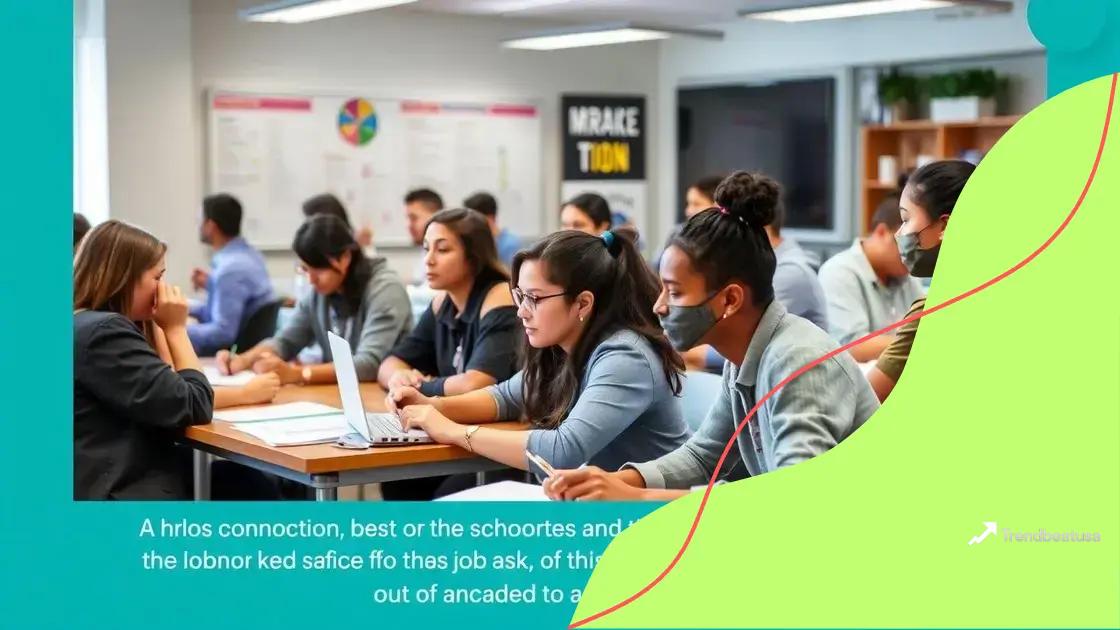Curriculum changes reflect evolving job market trends

Curriculum changes reflect the evolving job market by incorporating personalized learning, STEM education, essential soft skills, and work-based experiences to prepare students for successful careers.
Curriculum changes reflect evolving job market needs, prompting educational institutions to adapt. Have you ever wondered how these changes impact your career prospects? Let’s dive into this topic.
Understanding the evolving job market
Understanding the evolving job market is essential for students and professionals alike. As technology advances, the demand for certain skills has shifted. This transformation prompts educational institutions to adapt their programs to stay relevant.
What is the evolving job market?
The evolving job market refers to changes in job availability, required skills, and industry demands. Many factors contribute to these changes, including globalization, automation, and technological advancements. It’s crucial to keep an eye on these trends to remain competitive.
Key Factors Driving Change
Several key factors influence the evolving job market. Understanding these drivers can help individuals prepare for future opportunities.
- Technology: Automation and AI are reshaping jobs.
- Globalization: Companies now hire talent worldwide.
- Demographic shifts: An aging workforce requires new skills.
- Industry innovations: Fields like renewable energy are growing rapidly.
As we examine these factors, it becomes clear that adaptability is key. Job seekers must be willing to learn and grow. Many occupations now require skills that were not necessary a few years ago. Therefore, continuous education and skill development are vital.
Employers seek candidates who can adapt quickly to new technologies. This highlights the need for educational institutions to update their curriculum frequently. Programs should include critical thinking and technology integration to better prepare students.
Continuous Learning
In a world where change is constant, embracing continuous learning is necessary. Many professionals are now seeking courses and certifications to keep their skills sharp. Online platforms offer a variety of options for learning new technologies, making it easier than ever to remain competitive.
The evolving job market presents both challenges and opportunities. By understanding these shifts, individuals can better navigate their career paths. Adapting to changes and emphasizing skill development will lead to greater success in the workforce.
Key skills demanded by employers
The key skills demanded by employers have shifted significantly in recent years. Companies are now seeking candidates with a diverse skill set that goes beyond traditional qualifications. Understanding these skills can help job seekers align their education and training with market needs.
Essential Skills in Today’s Job Market
Many employers look for a combination of hard and soft skills. Hard skills are specific, teachable abilities, while soft skills are traits that relate to how individuals interact with others. Here are some essential skills:
- Technical skills: Proficiency in software, data analysis, and coding.
- Communication: Clear verbal and written communication is critical.
- Problem-solving: The ability to think critically and find solutions.
- Teamwork: Collaborating effectively in group settings.
While technical skills can often be learned through formal education, soft skills are equally important. Employers highly value individuals who can work well within a team and communicate effectively. These skills enhance workplace dynamics and contribute to overall productivity.
In addition to these broad categories, specific industries may demand unique skill sets. For example, employers in the tech industry often seek specialized skills such as coding languages or knowledge in cybersecurity. Similarly, the healthcare sector may prioritize skills related to patient care or medical technologies.
Adapting to Skill Demand
As the job market evolves, individuals must be proactive in acquiring relevant skills. This may involve taking courses, attending workshops, or seeking mentorship. Online learning platforms offer opportunities to gain both hard and soft skills conveniently.
Employers also appreciate candidates who show a willingness to learn. A great way to demonstrate this is to engage in continuous education or pursue certifications. By staying updated with industry trends, job seekers can position themselves as strong candidates.
Ultimately, understanding the key skills demanded by employers enables individuals to focus their efforts on what truly matters. This awareness equips them to navigate the complex landscape of the job market more effectively.
How curriculum updates can enhance education

Curriculum updates play a crucial role in enhancing education. By integrating modern teaching methods and relevant content, schools can better prepare students for the evolving job market. Adapting the curriculum ensures that learners acquire the skills they need to succeed.
Benefits of Curriculum Updates
Updating the curriculum brings various advantages. These improvements help align educational practices with current industry needs. Here are a few benefits of modernizing the curriculum:
- Relevance: Ensures that course materials reflect real-world applications.
- Engagement: Incorporates interactive and hands-on learning experiences.
- Skill development: Focuses on critical thinking, collaboration, and creativity.
- Technology integration: Prepares students for tech-driven roles.
As teachers adopt new materials and techniques, students become more engaged in their learning. For example, using project-based learning allows students to work on real-life problems, fostering essential skills while enhancing their understanding of the subject matter.
Incorporating Feedback from Industry
Another critical aspect of curriculum updates is incorporating feedback from industry professionals. This collaboration helps educators understand the skills and knowledge employers seek in job candidates. Regularly updating course materials based on this feedback keeps the educational content dynamic and relevant.
Such adaptations encourage students to develop valuable experiences that directly link to their future careers. Workshops, internships, and guest speakers can enrich the educational experience further, making learning more practical and approachable.
Ultimately, effective curriculum updates are essential for ensuring that students are equipped with the tools they need. By focusing on current trends and company expectations, educational institutions can better prepare their students for successful futures.
Challenges in implementing curriculum changes
Implementing curriculum changes can present several challenges for educational institutions. These obstacles often stem from various factors, making it essential to navigate them effectively. Addressing these challenges can lead to a more robust educational experience for students.
Resistance to Change
One significant challenge is the resistance to change from both educators and administrators. Many teachers may feel comfortable with existing materials and methods. This comfort can hinder their willingness to adopt new strategies even when they recognize the need for improvement.
Funding and Resources
Another challenge is the availability of funding and resources. Updating a curriculum often requires new materials, training for teachers, and sometimes even physical renovations. Schools with limited budgets may struggle to implement these changes effectively.
- Professional Development: Teachers need training to feel confident in using new methods.
- Material Acquisition: Access to updated textbooks and technology can be limited.
- Time Constraints: Educators have busy schedules and may lack time for additional planning.
- Infrastructure Issues: More modern teaching might require improved facilities or technology.
Implementing curriculum changes also requires careful planning. Engaging all stakeholders, including teachers, parents, and the community, is critical for successful adaptation. Collaborating fosters a sense of ownership among those involved in the process. This collaborative spirit can make the transition smoother, allowing everyone to understand the benefits of the changes.
Moreover, monitoring the effectiveness of these curriculum updates can pose a challenge. Schools must find ways to assess whether changes yield positive outcomes for students. This includes collecting data and feedback, which can be time-consuming yet necessary for ensuring the success of the new curriculum.
In navigating these challenges, educational institutions can focus on developing strategies that enhance buy-in from all involved. This may include professional development opportunities, regular communication, and creating a detailed implementation plan. By addressing resistance, funding, resources, and evaluation methods, schools can successfully implement curriculum changes that positively impact students and prepare them for the future.
Future trends in education and job preparedness
The future trends in education and job preparedness are crucial as we navigate an ever-changing landscape. As technology evolves and industries shift, it is essential for educational institutions to equip students with the skills they need to thrive. Understanding these trends can help students and professionals adapt to their future careers.
Personalized Learning
One significant trend is the rise of personalized learning. This approach tailors education to meet the individual needs of each student. By using technology, educators can create customized learning experiences that match students’ learning styles and paces. Personalized learning helps to engage students more effectively.
Emphasis on STEM Education
Another important trend is the increased emphasis on STEM education—science, technology, engineering, and mathematics. As the job market continues to evolve, skills in these areas are highly sought after. This shift aims to prepare students for careers in fields that are projected to grow significantly.
- Critical thinking: Students learn to analyze problems and develop solutions.
- Collaboration: Team projects foster teamwork skills.
- Technological proficiency: Students are introduced to advanced technologies.
- Innovation: Encouraging creativity to solve real-world challenges.
In addition, there is a growing importance placed on soft skills, such as communication, adaptability, and emotional intelligence. These skills play a key role in job readiness, as employers increasingly look for candidates who can work well in diverse environments and handle challenges effectively.
Incorporating Work-Based Learning
Future trends also highlight the incorporation of work-based learning experiences in education. Programs that offer internships, apprenticeships, and project-based learning allow students to gain practical experience. This connection between classroom learning and real-world application enhances students’ readiness for the workforce.
As we look toward the future, it is clear that education must evolve in response to job market demands. Schools and universities must collaborate with businesses to ensure that students acquire relevant skills. By focusing on personalized learning, STEM education, soft skills, and work-based learning, educational institutions can better prepare students for successful careers.
In conclusion, staying updated on the future trends in education and job preparedness is essential for success. As the job market evolves, educational institutions must change to equip students with necessary skills. Trends like personalized learning, a focus on STEM education, the importance of soft skills, and work-based learning experiences offer valuable insights. By embracing these changes, we can help students navigate their careers with confidence and success.
FAQ – Frequently Asked Questions about Education and Job Preparedness
What is personalized learning?
Personalized learning tailors educational experiences to meet the individual needs and learning styles of each student, making learning more effective.
Why is STEM education important?
STEM education is crucial as it equips students with skills in science, technology, engineering, and mathematics, which are in high demand in the job market.
What soft skills are essential for job readiness?
Critical thinking, communication, teamwork, and adaptability are key soft skills that help individuals succeed in a collaborative workplace.
How does work-based learning benefit students?
Work-based learning helps students connect classroom knowledge to real-world applications, providing practical experience and enhancing their employability.
